The inspiration…
What we’re thinking
Fasten your seatbelts for an exhilarating whirlwind tour of the progress economy! We’re diving into the key concepts that define this dynamic world: progress, progress propositions, value, innovation, and more…
…always on the search to enable more systematic innovation and firing up growth.
What is the progress economy?
The progress economy is a fresh view on our world. One that puts making progress as the central concept. Where value comes from making such progress. And innovation is naturally focussed on improving progress.
The progress economy is built on a foundation of service-dominant logic.
At its heart are three foundational mindset shifts from our traditional way of understanding the world:
Mindset shift #1
value creation
⇩
making progress*
*moving, over time, to a more desired state
Mindset shift #2
value EXCHANGE
⇩
Service* Exchange
*application of skills/competence to benefit oneself or another
MINDSET SHIFT #3
goods vs service
⇩
resource Mix*
*mostly interchangeable set of 6 resources (carriers of capability)
1. Stop creating value ⇒ Start making (or helping) make progress – moving over time to a more desirable state. ︾
Value emerges from progress (though, similar to revenue, needs to be recognised by the progress seeker in order to be real). When we base our innovation definitions and approaches around “creating” or “adding” value, we risk heading off into a world of disappointment, failure and missed opportunities (the innovation problem).
Instead, let’s recognise everyone is trying to make progress in everything they are interested in:
progress: moving over time to more desirable state
Where i) reaching that more desirable state implies maximum value has emerged for that progress seeker, ii) before starting the journey there is only the potential to reach a particular state (potential value) and iii) the more desired state – progress sought – may evolve during the progress attempt and between successive attempts.
With this mindset shift, we see that:
- value incrementally emerges as progress is made (value-through-progress)
- value is a trailing indicator of progress.
Importantly, this emerging value is abstract. To mean something to the progress seeking they need to “recognise” it. It’s similar to how revenue is recognised by businesses.
And this recognition may take place on a different schedule to emergence. For example, perhaps only at the end of the progress attempt; or maybe at the end of each progress-making activity; or at pre-defined milestones. Now we can answer questions like “how valuable is reaching 80km of a 100km journey?”. Well, it depends on the progress seeker’s value recognition approach.
Progress, like value, is a complex concept. But one we can neatly capture as a noun, a state, a verb, and a state transition. And we can define it in terms of functional, non-functional and contextual elements.
Two additional benefits of focussing on progress are that we get a:
- more actionable definition of innovation: helping improve progress made and reducing hurdles to progress
- powerful way to segment seekers (on progress origin and progress sought) to identify opportunities to help make progress
2. Stop selling outputs ⇒ Start interactively applying your skills and knowledge to help others make progress. Move beyond a point of sale and help make better progress through interaction and customisation. ︾
For centuries we’ve built our economy around exchanging value. We manufacture products, embedding value along the way, and sell them for cash.
As successful as this value-in-exchange perspective has been, we are hitting its limitations with respect to growth. The heavy focus on a point of exchange ignores what happens before and after that point, leaving missed opportunities. Moreover, it fools us into believing that we, as suppliers and producers, determine value.
In the progress economy we instead view the exchange of service – applying skills and knowledge for benefit – as the fundamental exchange. I help you progress and in return you help me progress*. This is Vargo & Lush’s service-dominant logic.
Now our focus is on how to help make progress – a process that occurs over time. We are invested in the whole journey, which increases our growth opportunities. Addressing the circular economy becomes natural (if that is part of the progress sought). And we can react to changes in progress sought during the journey.
A further implication of this thinking is that “price” no longer signals value. Instead it signals the equitable effort requested in return. I can propose that the effort involved in my service is 5 units. An equitable exchange (direct or indirect) would be for a service I need that also uses 5 units of effort.
And business model innovations flow naturally from this insight. For instance, 5 executions of a service with 1 unit of effort (subscription, credit) can meet that equitable exchange. So can a service of 3 unit effort together with 2 units of effort coming from another party (subsidisation).
* service exchange often occurs indirectly. For instance, through transitive exchanges – I help you progress, receiving service credits from you for that, which I could exchange with you later; but I can also use those credits to seek help with some progress from another party. Service credits can take various forms, including traditional currency like cash, cryptocurrencies, an IOU ledger, or even rocks; they mediate temporal and magnitude differences in service exchange.
3. Stop debating goods vs service ⇒ Start offering interchangeable resources that help make progress. Free yourself to slide across a continuum of relieving/enabling propositions to better meet your current and future progress seekers by recognising how, for instance, a goods and an employee are essentially interchangeable resources – carriers of capability. ︾
Our current world view is built around goods – the tangible items we sell. And we define services from that perspective – usually as poor relatives (intangible, inconsistent, inseparable, need involvement, no inventory)
By doing so, we create an unnecessary and constricting division.
In the progress economy, we look at things differently…defining service first and then seeing how goods fit:
service: applying skills and knowledge for another’s benefit
It turns out that goods freeze service; enabling it to be transported and unfrozen when/where needed.
Think about trying to entertain yourself. You could go and watch a live band playing. They apply their skills to instruments in order to entertain you. Or you could listen to their CD. Where you still get entertained by those same skills.
The same functional progress is made in both cases. Just in the first it happens immediately performed by employees, without you doing anything. Whereas in the other it happens through a goods where the original performance has been frozen and transported. And you have needed to do something (the huge task of hitting “play”).
These resources are practically interchangeable from a functional progress perspective.
This interchangeability allows us to build and offer different resource mixes to meet a particular progress sought. Where a proposition’s resource mix can include different levels of: employees, systems, goods, physical resources, data, locations.
Interestingly, altering the offered mix is an inspiration for innovation.
We see this in offerings that relieve people, “the shift to the service economy”, Platform as a Service, digitisation, and integration of artificial intelligence (AI), etc.
As well as in offerings that that enable people through increasing goods/systems elements of a mix . Such as home diabetes test tools or hospital at home approaches*, etc.
* my father was recently ill but rather than needing to remain on a hospital ward and be monitored, he was able to go home with a collection of measurement devices (heart rate, blood pressure monitor etc). He had to use those loaned items daily and report the figures via a tablet for remote monitoring. The resource mix shifted from employee based to goods and system based. He benefitted by being home and the health service benefitted from freeing up a bed.
The 9 key concepts
Here’s the 9 key concepts to know about the progress economy thinking:
- Everyone is trying to progress – move to a more desirable state – with everything in their life »»
- Often we lack the resources necessary to make a progress attempt (this is the primary progress hurdle) »»
- Progress propositions are packaged resources offered by progress helpers with a view to address that primary lack of resource progress hurdle »
- They fall on a continuum between enabling and relieving propositions (determined by who of the seeker and helper performs the majority of the progress-making activities) »
- But propositions introduce 5 additional progress hurdles – aspects that if to high cause us to not start, or abandon progress attempts »
- these hurdles are: adoptability, resistance, misalignment on continuum, lack of confidence and equitable exchange
- Value emerges from progress made, with maximum value emerging when a progress seeker reaches their progress sought. For various reasons, seekers often end up compromising progress reached and so maximum value is not achieved »
- As well as emerging, value also needs to be recognised. Something that may occur disjointly to it emerging »
- Innovation’s purpose is to improve progress made towards progress sought »
- Progress economy thinking enables the circular economy »
1. Everyone is trying to Progress
In the progress economy, we see everyone as on a quest to move towards more desirable states; in every aspect of their lives. That is, progress seekers are looking to progress. We’re talking about learning, fixing, impressing, building, enjoying, and much more.
progress – moving over time to a more desirable progress state.
We call this more desirable progress state progress sought. Like all progress state it comprises three elements:
- functional – the action (some form of people-, possession-, mind-, intangible-processing)
- non-functional – performance and feelings
- contextual – when/where/constraints.
All three elements are essential to truly understanding a seeker’s wishes and formulating successful propositions. From which we can see where job to be done theory of innovation emerges (and that helps us understand how to discover progress sought).
For practical reasons we look at specific aspects of progress at a time, rather than the substantial totality! And to make progress, we engage in progress attempts – executing a series of progress making activities. Where these activities are largely resource integrations between various combinations of operant and operand resources.
2. often we lack the resources to progress
Often we lack the resources to progress on our own. Maybe we don’t have the time. Or the skills or knowledge to know the progress-making steps or how to execute one or more of them.
We call this the lack of resources progress hurdle. And this hurdle might mean we don’t try to progress. Or we start a progress attempt, only to abandon it (this is the progress decision process).
We call it a hurdle, rather than a barrier, as some seekers will try and progress regardless.
But this is where progress propositions come in.
3. Progress propositions are offers to reduce the lack of resource progress hurdle
Progress propositions are like a helping hand from experts who have conquered similar challenges and want to assist others with their progress. We call these experts progress helpers. They offer propositions that aim to minimise the lack of resource progress hurdle.
Progress proposition – an offer of resources (specific mix+ proposed activities) to help make some defined progress – the progress offered
Progress propositions offer a path towards the progress state of progress offered by providing two key resource components:
- A proposed set of progress-making activities: the specific steps you need to take to move closer to progress sought…perhaps better known as instructions, recipes, techniques, contractual terms, and so on, or captured in a process
- A mix of supplementary resources: a proposition specific mix of knowledge and skill encapsulating resources…employees, systems, data, goods, physical resources, and locations.
This resource mix is specific to a proposition. But, interestingly, altering the offered mix is a fingerprint of many innovations, such as digitisation, digital twins, introducing AI, platform as a service etc.
While there’s a necessary connection between a proposition’s progress offered and the seeker’s progress sought it doesn’t have to be an exact match. Seekers often compromise to progress offered if it is, for example, easier to make.
And helpers may offer progress to a mainstream seeker which is less than the demanding progress sought but more than least demanding. In fact, this difference is where approaches such as disruptive innovation and Blue Ocean strategy find their place in the progress economy.
Helpers offer propositions because they seek to maximise their equitable service exchange. They, themselves, are in need of service (the application of skills and knowledge for another’s benefit) – their employees, suppliers, landlords etc. And since service is fundamental basis of exchange, they are encouraged to offer service to get service. This exchange is often indirect, and disjoint in time and size. All that is mediated by service credits (of which money is a common example) in equitable service exchanges.
4. Progress proposition fall on a continuum
When you (as the seeker) engage a progress proposition, progress becomes a joint endeavour. Both you and the helper work together to attempt progress. And who executes the necessary progress-making activities gives us insights into the proposition, resource mix and non-functional progress.
Some propositions, called enabling propositions, have the seeker executing the activities on their own. And the seeker might even ignore the helper’s proposed series of progress-making activities. Who reads the instructions on a new gadget you’ve just bought, right?
Other propositions, called relieving propositions, have the helper executing most of the activities. Many propositions fall somewhere in between these two types on what we call the progress proposition continuum.
progress proposition continuum – a continuum between enabling and relieving propositions on which all progress propositions sit.
This continuum tells us interesting things about the non-functional and contextual progress offered. As well as the types of resources offered in the resource mix. And vice-versa, knowing the cntextual and non-functional progress sought points us to position on the continuum.
Enabling propositions usually have more goods involved, and they appeal to seekers who want to achieve things themselves, as well as avoiding being held-up. Relieving propositions, on the other hand, rely more on employees and systems in the resource mix, appealing, for example, to seekers with lack of time or helping with more complicated progress-making activities.
The continuum also reveals a progress hurdle. It’s the distance between where your proposition falls on the continuum and what the seeker wants. If a seeker is looking for a relieving proposition, like when they lack time, but your proposition is more towards the enabling end, it can become too big a hurdle to overcome and they may not engage.
There are also a few more hurdles that propositions introduce.
5. But they introduce additional progress hurdles
While propositions aim to overcome an original lack of resource progress hurdle, they may not reduce the hurdle completely. And they may introduce new lack of resource issues. Imagine being offered a shiny new fly yourself aircraft service to help you make travel progress…but lacking the skills or knowledge on how to fly.
Progress hurdles – factors that if uniquely and phenomenologically felt by a progress seeker as too high, may lead them to decide to not start, or to abandon, a progress attempt.
And, the very arrival of a progress proposition introduces five additional progress hurdles. Here’s all six:






| hurdle | description |
|---|---|
| lack of resource | how much resource does the progress seeker feel they lack in order to progress |
| adoptability | how readily does the progress seeker feel they are able to engage the progress proposition |
| resistance | how much resistance – none, postpone, reject, or worse, oppose – does the progress seeker feel towards the proposition |
| misalignment on continuum | how far away, on the progress continuum, does the progress seeker feel the proposition is compared to their own position |
| lack of confidence | how much confidence does the progress seeker have in the progress proposition and/or progress helper |
| equitable service exchange | how many service credits – amount and frequency – does a progress seeker need to get from elsewhere in order to meet that requested by the progress helper in order to engage the progress proposition (more formally: to participate in service exchange) |
If a seeker phenomenologically feels any of these hurdles are too high before or during a progress attempt they might not start, or abandon, that attempt.
The seeker’s progress attempt uses the engagement decision process to determine whether to start, and continue, engaging with a progress proposition. That includes judging the 6 progress hurdles, together with views on progress potential and progress reached.
6. Value emerges from progress
When we talk about value, we usually think in terms of goods economy value-in-exchange: exchanging goods for money. Manufacturers add value to their products through the manufacturing process and then sell that embedded value to us for cash. We then use-up/destroy that value and so need replacement goods. While this goods economy mindset has fuelled growth for several centuries, it limits our understanding of value.
Once we free our minds of that thinking, we discover value is more complex. But it is through understanding this more complex view we find the key to innovation, growth, and enabling the circular economy.
In the progress economy, value is seen as emerging from progress – value-through-progress. The more progress we make, the more value we create. Of course, progress is a joint effort when we engage with a proposition, and so value is co-created. This is better understood as value-in-use.
To fully grasp the concept of value, we also need to consider its recognition – a term we borrow from accounting. Value continuously emerges as we make progress. However, recognition of it may not happen continuously.
Consider setting out to travel 100km but only reaching 80km. What value has been created. Well, 80% has been (co-) created. But have we really gotten 80% worth of value? Or have we got 0%, or somewhere in between? Well, it is a unique judgment made by the progress seeker, influenced by the context of the situation.
Judging progress/value
Seekers and helpers make several unique and phenomenological judgements of progress states that relate to value:
value – emerges from unique and phenomenological judgements of progress; before, during and after a progress attempt
- Progress sought – reaching this state creates maximum value for the seeker
- Progress potential (seeker) – where seeker thinks they can reach on an attempt, if too low then making progress is not seen as valuable
- Progress potential (helper) known as Progress offered – where a helper believes they can help a seeker reach. Often a compromise to progress sought, so seeker’s maximum value cannot be co-created, but if seeker accepts proposition then reaching progress offered is the maximum value that can be co-created.
- Progress reached – a continuous judgement, predominantly by the seeker: are they at the place in the progress attempt they expected to be at this point. Similar judgement might be made by helper (though less so as we head closer to enabling propositions on the progress continuum). Shortfalls in progress reached judgements are interpreted as value co-destruction and may cause the seeker to abandon the attempt. In rarer cases the helper may come to same conclusion.
If a seeker or helper starts hampering progress, we might be observing value co-destruction.
Value may also start being created pre- and continue post- engagement of a proposition’s progress-making activities. For example with any didcussions on tailoring the proposition.
7. Innovation’s sole purpose is to improve progress
Finally we land on innovation. And we can get past the traditional way of looking at it. We can summarise that as saying innovation is creating something new that adds value. Which, to me, is quite wishy-washy.
Until now, value was hard to define in a usable way. Now we know that value emerges from progress. So innovation should be something that improves progress reached. Additionally, we know there are progress hurdles – one if the seeker attempts progress on their own and six if with a proposition.
Innovation, then naturally becomes a case of finding, and executing, some combination of:
- reaching closer towards progress sought
- making existing progress better
- reducing one or more of the hurdles to progress
Innovation can be carried out by both seekers and helpers. A small number of seekers feel the desire to innovate if they cannot progress and there are no suitable propositions available to assist them. Or, sometimes, just if they feel like it. If they succeed in their innovative efforts, they may even become helpers themselves, offering their newfound skills and knowledge to others.
Helpers are driven by the goal of maximising equitable service exchange.
the purpose of a progress helper is to attract maximum equitable service exchange (number or size) with progress seekers – as such a progress helper has three, and only three, functions:
reworded from Drucker
- marketing – continuous discovery of ever evolving progress sought
- executing – delivery of progress offered
- innovating – continuous innovation of progress offered towards the ever evolving progress sought
To achieve this, they need to innovate to find ways to help seekers reach their progress sought more effectively and overcome hurdles with greater ease. By offering improved assistance and reducing barriers to progress, helpers can increase the likelihood of engaging in valuable service exchanges.
But also, progress sought by seekers is ever-evolving. What may be considered valuable assistance today could become less useful over time. If a proposition fails to adapt it may become less relevant in the eyes of seekers. Therefore attracting less service-exchange.
Innovation levers
Fortunately, the progress economy gives us a number of levers to systematically hunt for innovation:
- progress sought – get a better understanding of seeker’s need and create progress offered
- progress sought vs progress offered
- how can we improve progress offered compared to progress sought
- can we segment by progress sought and improve for some segments (disruptive innovation sits here)
- can we find new segments (perhaps using tools from blue ocean strategy)
- Progress-making activities – can we simplify / improve
- Progress resource mix
- can it be altered to help make progress better?
- can the elements used be improved (increased skills and knowledge)
- has seeker learnt things in other markets/industries we can leverage?
- Proposition continuum – can we get closer to seeker’s position
- Progress hurdles – can we reduce them
8. Firing up growth
The focus on progress in the progress economy and its definition of innovation leads us to draw conclusions about the role of a helper and how it can be effectively organized. A helper’s primary task is to identify the specific progress sought by a seeker, determine how they can provide assistance, and ensure they have the capability to execute that assistance. Since the progress sought is continuously evolving, this process becomes a continuous cycle of adaptation and improvement.
In light of this, we can reframe Peter Drucker’s well-known perspective on “the purpose of a firm” as:
the purpose of a progress helper is to attract maximum (size or number) of equitable service exchanges – as such a progress helper has three, and only three, functions:
- marketing – continuous discovery of ever evolving progress sought
- executing – delivery of progress offered
- innovating – continuous innovation of progress offered towards the ever evolving progress sought**
And flowing from this purpose, there must be one role that is accountable for all three functions for each progress offered. We call that role the progress owner. The rest of the organisation supports that role and the three functions.
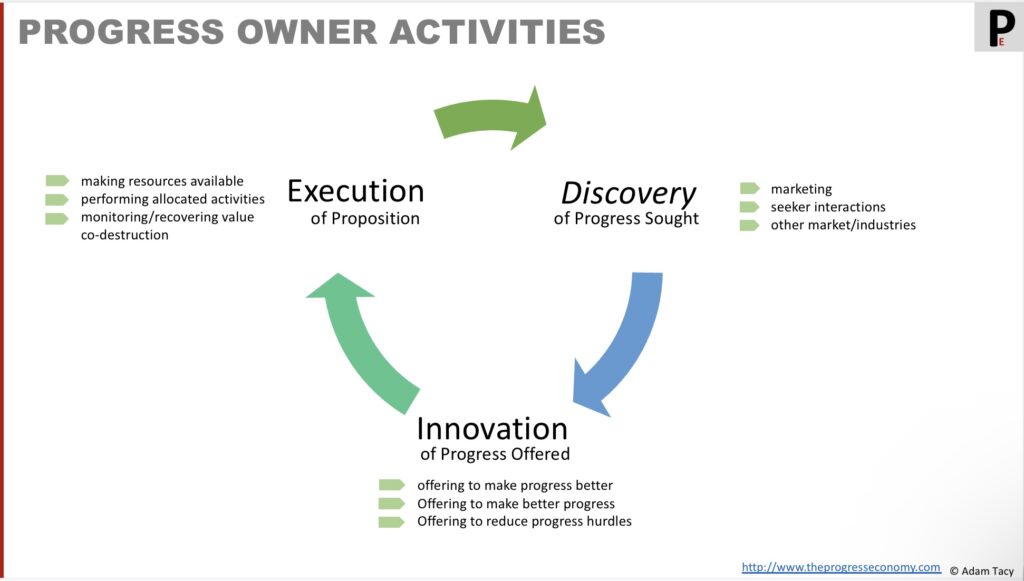
This progress owner can be seen as a somewhat expanded version of agile product owner (which, due to its focus on product rather than progress, typically focusses on executing, and sometimes innovation).
9. Enabling circular economy
The traditional goods economy thinking of value-in-exchange aligns closely with the linear economy’s take-make-waste model. We embed value into products, exchange them for money, and then progressively use that value up or destroy it fairly instantly.
It’s easy to be cynical and think that manufacturers have little incentive to look beyond the moment of exchange. After all, it benefits them if customers need to buy replacement goods, leading to another value exchange and more cash for the manufacturer.
one of the biggest challenges…to transition from linear to circular is that it requires…revisiting the very notion of value creation
Ellen MacArthur Foundation (2023) “From ambition to action: an adaptive strategy for circular design”
When we adopt a progress economy perspective, everything changes. The focus shifts from value-in-exchange to making progress. This opens up the possibility of embracing circular economy thinking by including it as part of the progress sought. Doing that:
- takes our mindset beyond focussing on a point of exchange
- encourages helpers to
- encapsulate skills and knowledge of reuse, recycle etc into any goods elements of their resource mix along with functional skills and knowledge
- explore shifting the resource mix away from including goods
- update their ways of working
- see the potential for extended propositions
Externalities
Sometimes, externalities need to step in to enforce circular progress sought. For instance, countries like Sweden have implemented schemes like the plastic bottle deposit system, which creates incentives for people to recycle by imposing a deposit fee on plastic bottles. Or the european union trying to reduce mountains of different phone chargers by mandating the progress sought of recharging a phone battery must have contextual progress element of using USB-C.
By shifting our mindset to a progress economy and incorporating circular thinking, we can foster a more sustainable and efficient approach to co-creating value beyond a moment of exchange.
Key considerations
- Everyone is trying to Progress
- can you identify your seekers’ progress sought? and progress origin? (where they want to get to, and where they are)
- how can you help them progress?
- Often we lack the resources to progress
- can you identify what operant/operand resources your seekers are lacking which prevent them making progress to their progress sought?
- Progress propositions are offers to reduce the lack of resource progress hurdle
- what resources (skills and knowledge encapsulating entities) have you got, or can readily acquire/offer from network, to supplement seekers and help them progress
- Progress proposition fall on a continuum
- do you want to enable or relieve the seeker?
- does the seeker want to be enabled or relieved?
- Progress propositions introduce additional progress hurdles
- do you understand the hurdles your proposition introduces?
- have you minimised those hurdles?
- Value emerges from progress
- do you understand how your seekers will recognise value co-created through progress
- Innovation’s sole purpose is to improve progress
- How can you help
- seekers make existing progress better?
- seekers reach closer their progress sought?
- minimise one or more of the six progress hurdles?
- What are your seekers doing in other markets/industries to make progress they could be doing (or are expecting to do) in yours? (the QR code story)
- Are you on top of understanding the ever evolving progress sought
- How are you leveraging the innovation levers from the progress economy?
- How can you help
- Firing up growth
- Are you organised to drive the 3 functions of a helper: marketing (understanding), innovation and execution?
- Enabling circular economy
- is it truly part of progress sought by your seekers? are externalities enforcing circular progress sought
- are you
- encapsulate your skills and knowledge of reuse, recycle etc into any goods elements of your resource mix?
- shifting the resource mix away from including goods
- updating your ways of working
- exploring extending your propositions (directly or ecosystem-wise) to address circular actions?
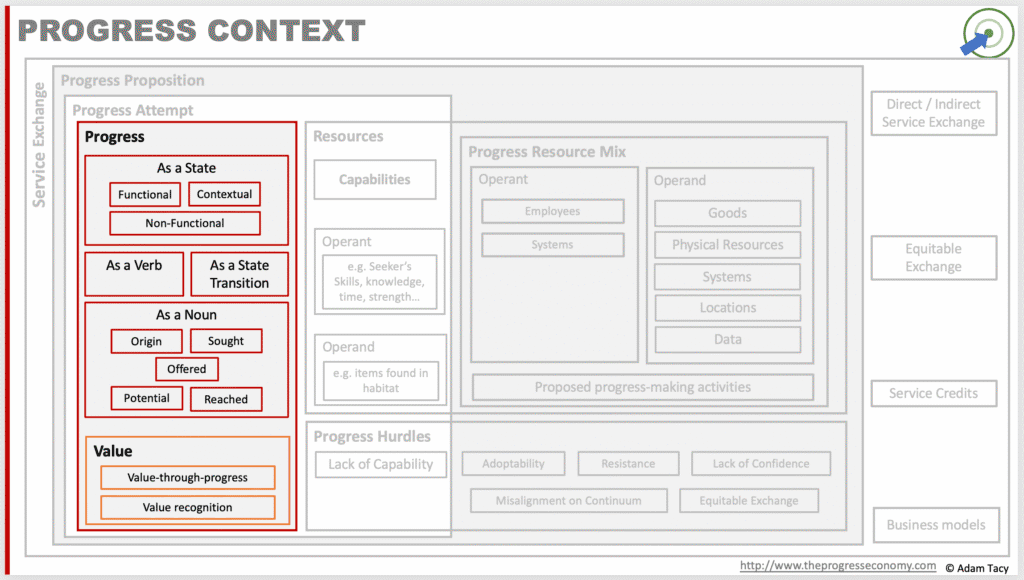
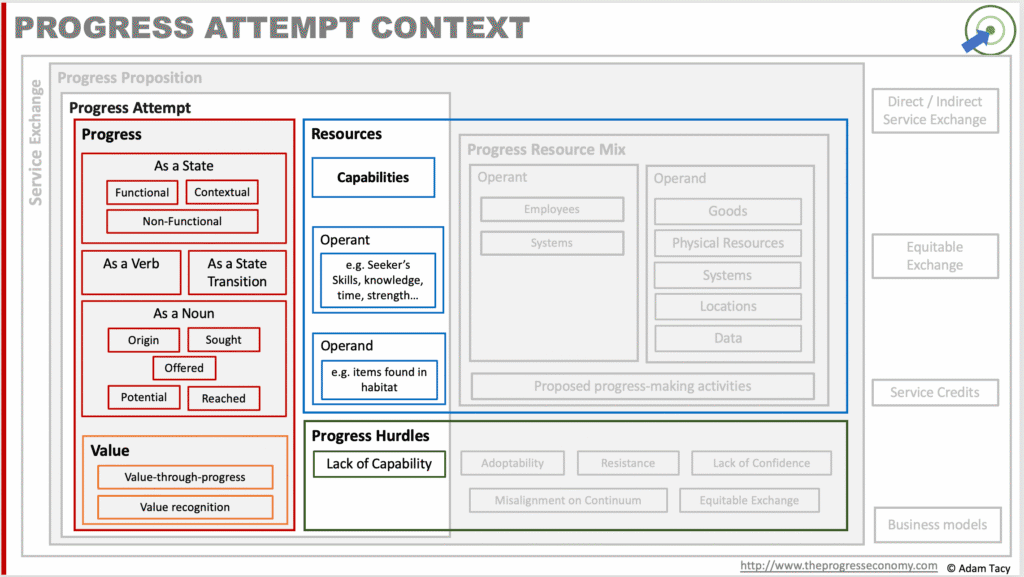


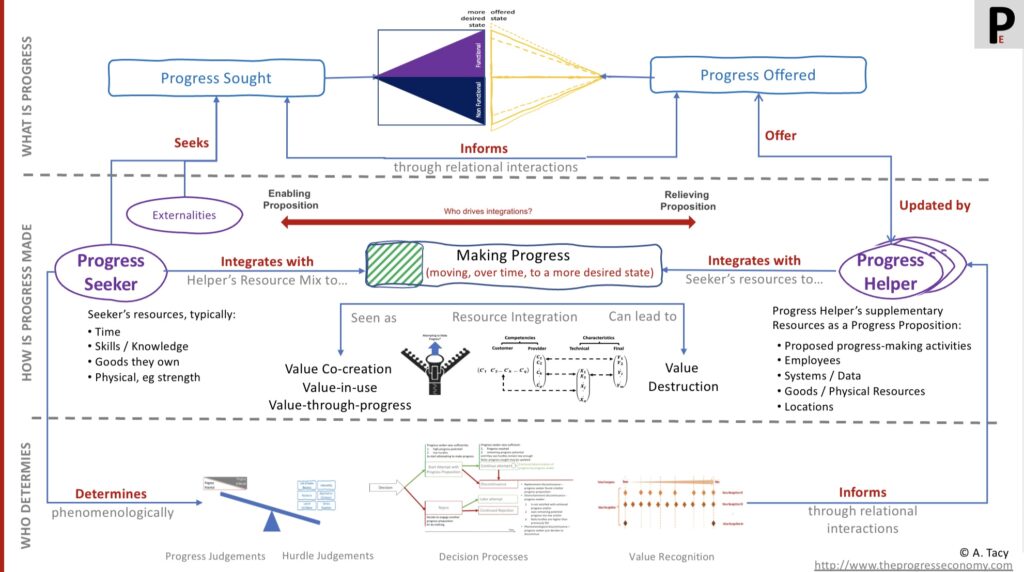
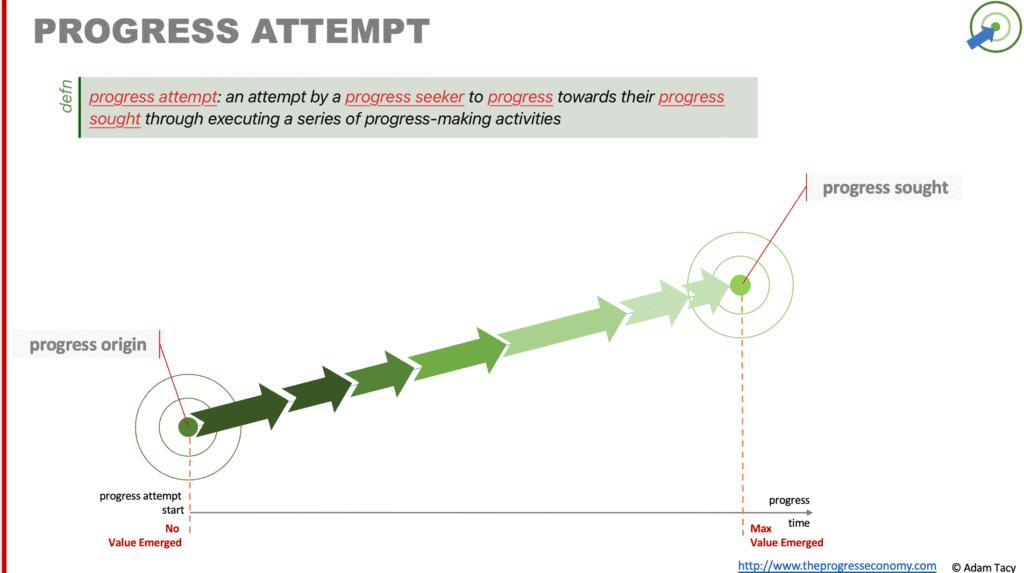

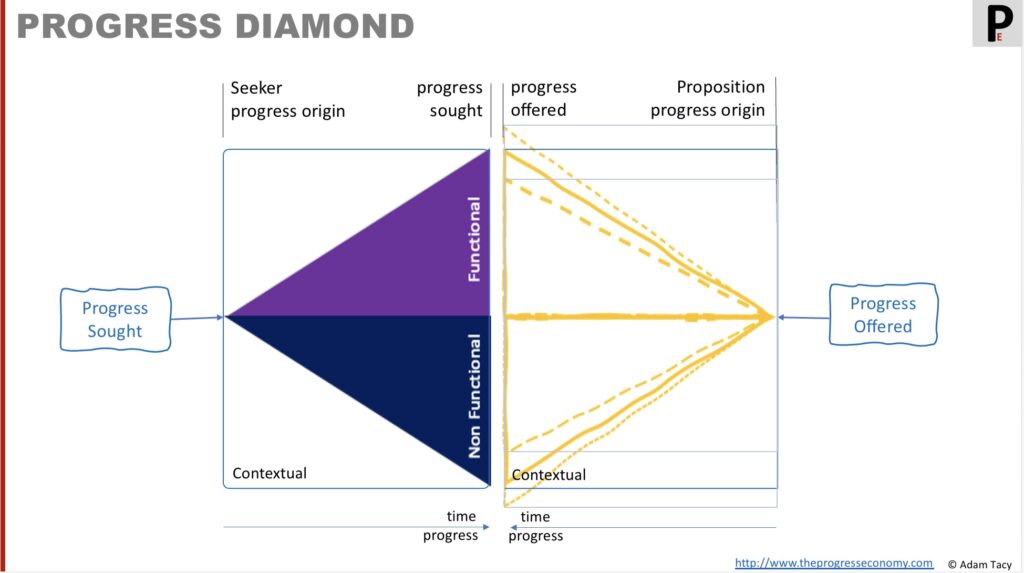




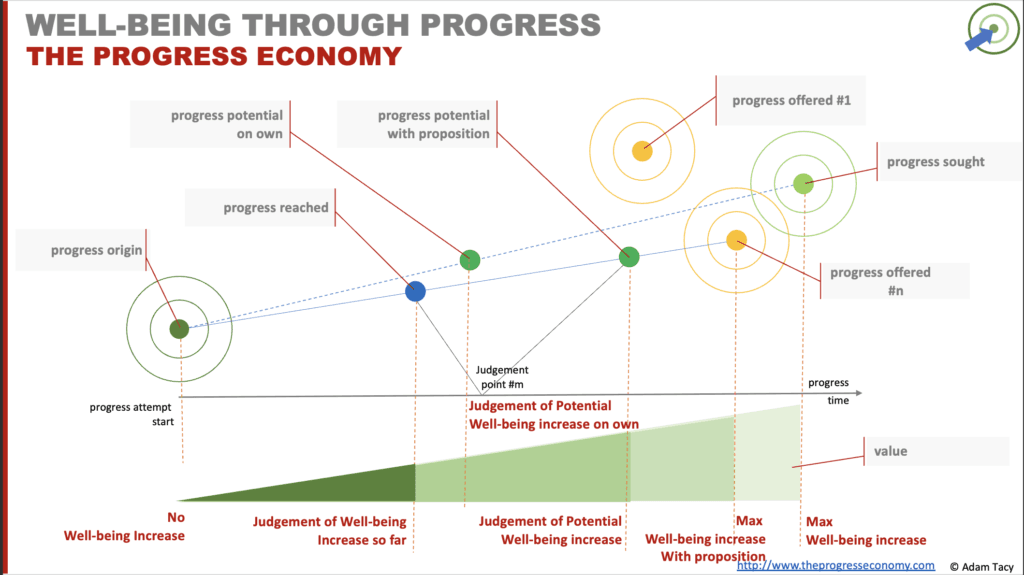
Let’s progress together through discussion…